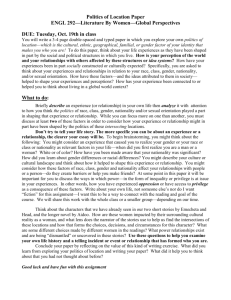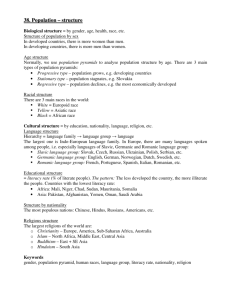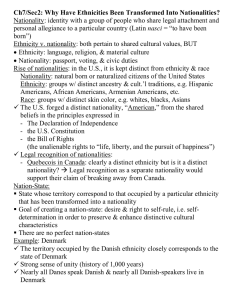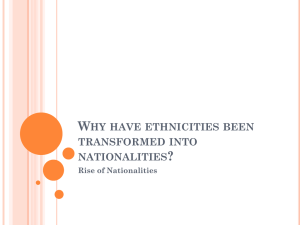Population by Country of Birth and Nationality Report, August 2012 Foreword
advertisement
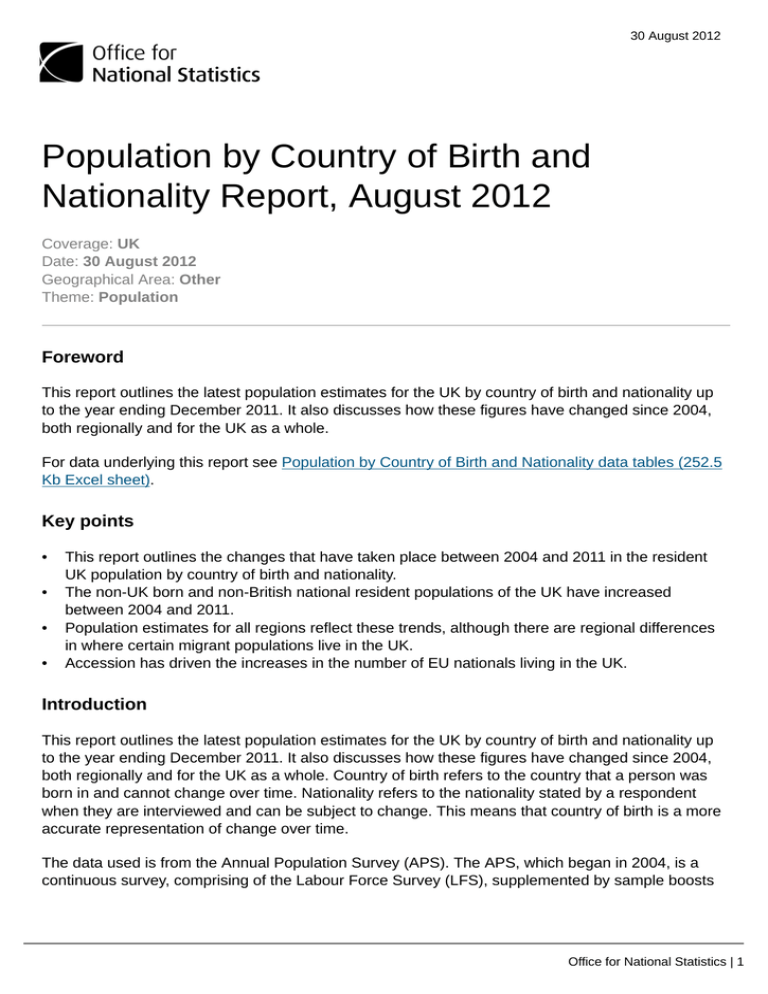
30 August 2012 Population by Country of Birth and Nationality Report, August 2012 Coverage: UK Date: 30 August 2012 Geographical Area: Other Theme: Population Foreword This report outlines the latest population estimates for the UK by country of birth and nationality up to the year ending December 2011. It also discusses how these figures have changed since 2004, both regionally and for the UK as a whole. For data underlying this report see Population by Country of Birth and Nationality data tables (252.5 Kb Excel sheet). Key points • • • • This report outlines the changes that have taken place between 2004 and 2011 in the resident UK population by country of birth and nationality. The non-UK born and non-British national resident populations of the UK have increased between 2004 and 2011. Population estimates for all regions reflect these trends, although there are regional differences in where certain migrant populations live in the UK. Accession has driven the increases in the number of EU nationals living in the UK. Introduction This report outlines the latest population estimates for the UK by country of birth and nationality up to the year ending December 2011. It also discusses how these figures have changed since 2004, both regionally and for the UK as a whole. Country of birth refers to the country that a person was born in and cannot change over time. Nationality refers to the nationality stated by a respondent when they are interviewed and can be subject to change. This means that country of birth is a more accurate representation of change over time. The data used is from the Annual Population Survey (APS). The APS, which began in 2004, is a continuous survey, comprising of the Labour Force Survey (LFS), supplemented by sample boosts Office for National Statistics | 1 30 August 2012 in England, Scotland and Wales. The APS is a survey of households in the UK, so does not include communal establishments. It is important to note that all figures contained in this report refer to estimates from the APS and do not refer to any data collected as part of the 2011 census. The population by country of birth and nationality figures will be updated as new data become available. 1. What are the latest figures? United Kingdom Figures 1.1 and 1.2 show the latest estimates for the UK population by country of birth and nationality. The proportion of the resident population born outside the UK is larger than the proportion of resident non-British nationals. This suggests that many UK residents born outside the UK assume a British nationality. Figure 1.1 Estimated Resident Population of the UK by Country of Birth, 2011 Source: Annual Population Survey (APS) - Office for National Statistics Notes: 1. Figures are listed in thousands Download chart XLS format (18 Kb) Office for National Statistics | 2 30 August 2012 Figure 1.2 Estimated Resident Population of the UK by Nationality, 2011 Source: Annual Population Survey (APS) - Office for National Statistics Notes: 1. Figures are listed in thousands Download chart XLS format (24 Kb) Of UK residents born outside the UK, the majority are born in non-EU countries, as shown in Table 1.1. Table 1.2 shows the nationalities of the non-British UK population in 2011. The difference between the non-EU country of birth estimate and the non-EU nationality estimate suggests that nearly half of those residents born outside of the EU do not hold non-EU nationality. Table 1.1: Estimated Resident Population of the UK by Non-UK Country of Birth, Calendar Year 2011 thousands Non-United Kingdom Republic of Ireland European Union 26 European Union 8 European Union 13 Rest of the World estimateCI +/- estimateCI +/- estimateCI +/- estimateCI +/- estimateCI +/- estimateCI +/- 7,509 397 2,517 988 911 4,992 120 28 69 44 42 98 Office for National Statistics | 3 30 August 2012 Table source: Office for National Statistics Table notes: 1. EU26: Between 2004 and 2006 this grouping was known as the EU24 and included the countries in the EU13, the Republic of Ireland, EU8, Malta and Cyprus. In 2007 this grouping became the EU26, to include Bulgaria and Romania, who acceded to the EU on 1st January 2007 2. EU13: This is shown only on the country of birth tables. It includes the countries of the EU, other than the UK and Republic of Ireland, as constituted between 1 January 1995 and 1 May 2004 (i.e. Austria, Belgium, Denmark, 3. 4. Finland, France, Germany, Greece, Italy, Luxembourg, Netherlands, Portugal, Spain and Sweden). EU8: These are the eight Central and Eastern European countries that acceded to the EU on 1 May 2004 (Czech Republic, Estonia, Hungary, Latvia, Lithuania, Poland, Slovakia and Slovenia). CI +/- refers to Confidence Intervals which denote the range within which the true value of a population parameter lies with known probability (95%). Caution should be exercised when an estimate is accompanied by a large confidence interval, which may indicate a less reliable figure. Download table XLS format (26.5 Kb) Table 1.2: Estimated Resident Population of the UK by Non-British Nationality, Calendar Year 2011 thousands Non-British European Union 26 European Union 14 European Union 8 Rest of the World estimate CI +/- estimate CI +/- estimate CI +/- estimate CI +/- estimate CI +/- 4,772 96 2,283 66 1,091 46 1,038 45 2,489 69 Table source: Office for National Statistics Table notes: 1. Because people born in Northern Ireland have the right to British and/or Irish nationality/citizenship, the two nationalities have been combined for Northern Ireland in the nationality tables in this report. Non-British consists of all other nationalities except British, apart from Northern Ireland where it consists of all other nationalities except 2. 3. 4. 5. British and Irish. EU26: Between 2004 and 2006 this grouping was known as the EU24 and included the countries in the EU13, the Republic of Ireland, EU8, Malta and Cyprus. In 2007 this grouping became the EU26, to include Bulgaria and Romania, who acceded to the EU on 1st January 2007. EU14: This is shown only on the nationality tables. It is all those countries in the EU13 grouping plus the Republic of Ireland. EU8: These are the eight Central and Eastern European countries that acceded to the EU on 1 May 2004 (Czech Republic, Estonia, Hungary, Latvia, Lithuania, Poland, Slovakia and Slovenia). CI +/- refers to Confidence Intervals which denote the range within which the true value of a population parameter lies with known probability (95%). Caution should be exercised when an estimate is accompanied by a large confidence interval, which may indicate a less reliable figure. Office for National Statistics | 4 30 August 2012 Download table XLS format (26.5 Kb) 2. Changes over time United Kingdom There has been no statistically significant change in the estimated UK-born population of the UK since 2004. The non-UK born population of the UK has increased, from 5,233,000 in 2004 to 7,509,000 in 2011. Figure 2.1 shows the changes that have taken place in the non-UK born population between 2004 and 2011. Of those born outside the UK, the estimated population born in the EU8 countries increased significantly between 2004 and 2008, from 167,000 to 689,000. This increase was driven by Accession and the widened opportunities for EU8 nationals to live and work in the UK. This growth slowed between 2008 and 2010 to a level that was not statistically significant year-on-year, but increased again in 2011 to 988,000, up from 805,000 in 2010. The population of the UK born in EU26 countries has also increased steadily between 2004 and 2011. The estimated UK population of those born outside both the UK and the EU also steadily increased over the same period, from 3,741,000 to 4,992,000. Office for National Statistics | 5 30 August 2012 Figure 2.1 Estimated Resident Population of the UK by Country of Birth Source: Annual Population Survey (APS) - Office for National Statistics Download chart XLS format (24.5 Kb) With regards to the UK population by nationality, all nationality groupings increased in number between 2004 and 2011, including those from within and outside the EU. Of the non-British nationalities, trends were similar to those observed in country of birth, with a large increase in the number of EU8 nationals, from 125,000 in 2004 to 1,038,000 in 2011. Unlike country of birth increases for this population, which slowed down between 2008 and 2010, the EU8 population by nationality grew steadily over this period. The number of EU26 nationals resident in the UK doubled between 2004 and 2011, from 1,094,000 to 2,283,000. England The populations of England by UK country of birth and by British nationality have shown marginal increases between 2004 and 2011. The population of England born outside the UK has significantly increased over the same period, from an estimated 4,859,000 in 2004 to 6,908,000 in 2011. This statistically significant increase is reflected in measures of population by non-British nationality. The changes that have taken place in the non-UK born and non-British populations of England over this period broadly reflect those that took place in the UK population as a whole, which are shown Office for National Statistics | 6 30 August 2012 in Figure 2.1. For example, the increase in the EU8-born and EU8 national populations recorded at UK level are reflected in England, where the number of resident EU8 nationals increased from an estimated 120,000 in 2004 to 891,000 in 2011. There have also been significant increases in the EU26 population over this period, both measured by country of birth and by nationality. The population born outside the UK and the EU has increased by 1,152,000 since 2004 to its estimated level in 2011 of 4,673,000. A statistically significant increase also occurred in the estimated population of non-British nationals in England over the same period. The following three sections consider whether these general patterns of non-UK born and nonBritish national population increases are reproduced across the UK constituent countries. The smaller populations of Wales, Scotland and Northern Ireland make calculating reliable estimates more difficult. Users are advised to be cautious when making inferences from estimates with large confidence intervals. Figure 2.2: Estimated Resident Population by Non-UK Country of Birth and Non-British Nationality for Scotland, Wales and Northern Ireland, 2004-2011 Source: Annual Population Survey (APS) - Office for National Statistics Download chart XLS format (25 Kb) Wales Office for National Statistics | 7 30 August 2012 There were statistically significant increases in the non-UK born and non-British population of Wales, from 2004 to 2011, as shown in Figure 2.2. Of the non-UK born population of Wales, there were increases in the population born in EU26 countries and in the rest of the world, although these increases were more gradual than those which occurred in England. The number of nationals from outside the UK and the EU also gradually increased, from an estimated 32,000 in 2004 to 52,000 in 2011. The population of Wales born in EU8 countries and the population of EU8 nationals increased between 2005 and 2007 before stabilising between 2007 and 2011 at around 20,000 people. Scotland The changes in the population of Scotland are similar to those that took place in Wales. Figure 2.2 shows the increases in the population of Scotland born outside the UK and those of nonBritish nationality. Of the non-UK born population, the population born in the EU26 doubled in this period, from an estimated 69,000 in 2004 to 154,000 in 2011. The population born outside the EU also increased over this period and both these increases are reflected in population by nationality statistics. Like the UK population as a whole, the population of Scotland, born in the EU8, increased between 2004 and 2011 (although the earlier figures are less reliable than the latest estimates). Significant periods of growth for this population occurred between 2006 and 2008, and between 2010 and 2011, which are similar to the trends in Wales. The population of Scotland by EU8 nationality statistics also reflect this increase, with significant growth between 2004 and 2008, again reflecting the impact of EU8 Accession. Northern Ireland Figure 2.2 shows that the population of Northern Ireland born outside the UK and the population of non-British nationals increased between 2004 and 2011. There was a slight decline in the number of residents born in the Republic of Ireland and increases in the populations of those born in the EU26 and the rest of the world, but none of these are statistically significant changes. With regards to the EU8-born population, although significant increases were seen between 2005 and 2007, the low numbers in this population make these estimates less reliable. The same applies to increases in the estimated number of EU8 and EU26 nationals. Notes 3. Which countries are non-UK born residents and non-British nationals from? The five most common non-UK countries of birth in the UK population between 2004 and 2011 (shown in Figure 3.1) have remained largely consistent, with India the most common non-UK country of birth each year. There was more variation in the most common non-British nationalities in the UK (shown in Figure 3.2) than in country of birth between 2004 and 2006, but from 2007 to 2011 the five most common non-British nationalities remained the same. Office for National Statistics | 8 30 August 2012 Figure 3.1 Estimated Resident Population of the UK by Most Common Non-UK Countries of Birth, 2004-2011 Source: Annual Population Survey (APS) - Office for National Statistics Notes: 1. Figures 3.1 and 3.2: The dotted lines denote an estimated population that was not one of the five most common in that particular year. In 2004 and 2005, Bangladesh was the fifth most common non-UK country of birth, but was overtaken by Poland in 2006. Therefore, Poland, rather than Bangladesh, has been included in Figure 3.1 Download chart XLS format (25.5 Kb) Office for National Statistics | 9 30 August 2012 Figure 3.2 Estimated Resident Population of the UK by Most Common Non-British Nationality, 2004-2011 Source: Annual Population Survey (APS) - Office for National Statistics Notes: 1. Figures 3.1 and 3.2: The dotted lines denote an estimated population that was not one of the five most common in that particular year. In 2004 and 2005, Bangladesh was the fifth most common non-UK country of birth, but was overtaken by Poland in 2006. Therefore, Poland, rather than Bangladesh, has been included in Figure 3.1. Download chart XLS format (25.5 Kb) Figures 3.1 and 3.2 show a significant increase in the Polish population, particularly between 2004 and 2008. This suggests that EU8 Accession in 2004 enabled more people from Poland to live and work in the UK. The slowing down of this increase in 2008 could be attributed to the impact of economic recession. A comparison of Figures 3.1 and 3.2 also shows that there are fewer nationals of India and Pakistan resident in the UK than there are residents who were born in these countries. This indicates that residents born in India and Pakistan may be more likely to assume British nationality than other non-UK born residents. Notes 4. Where within England are residents born outside the UK and non-British nationals settling? Regions of England Office for National Statistics | 10 30 August 2012 Table 4.1 shows that the proportions of non-UK born and non-British residents have increased in all regions in England between 2004 and 2011, although the size of this increase varies between localities. Table 4.1: Estimated Resident Population by Non-UK Country of Birth and Non-British Nationality, Regions of England, Calendar Years 2004 and 2011 Region of England Estimated Proportion Born Outside the UK (% of total regional population) Estimated Proportion of Non-British Nationals (% of total regional population) 2004 2011 2004 2011 North East 3.3 4.8 1.8 2.9 North West 5.1 8.0 2.7 5.0 Yorkshire & The Humber 5.9 8.4 2.8 5.4 East Midlands 6.2 9.7 3.2 6.1 West Midlands 7.6 11.0 4.0 6.4 East 7.2 10.8 4.1 7.4 29.6 36.1 17.7 22.8 South East 8.3 11.3 4.5 6.9 South West 5.0 7.3 2.5 4.3 England 9.8 13.3 5.8 9.1 London Table source: Office for National Statistics Download table XLS format (19 Kb) With regards to which countries non-UK born residents were born in and the nationalities of nonBritish residents, many of the regions reflect the trends of England as a whole. It is more difficult to establish whether regional variations are statistically significant due to the wide confidence intervals associated with the estimated values. Nevertheless, there are some regional variations that should be noted. In the North East, Germany was amongst the two most common non-UK countries of birth between 2004 and 2011, compared to ranking between fourth and fifth for England. In the North West and Yorkshire and the Humber, Pakistan has been the most common non-UK country of birth throughout the same period, although this was only a statistically significant difference in 2009 and 2010. Pakistan was also frequently ranked as a more common nationality in these regions compared to estimates for England. In the West Midlands, Pakistan and India have been the two most common non-UK countries of birth between 2004 and 2011. Office for National Statistics | 11 30 August 2012 The West Midlands has a higher estimated population of Jamaican-born residents than England as a whole. However, these trends were not as clearly reflected in figures for non-British nationality, which were more similar to the trends for England as a whole. An important difference in the South East and South West regions was the higher ranking of South Africa as one of the five most common non-UK countries of birth. This trend occurred between 2004 and 2010 in the South East and between 2004 and 2011 in the South West, but was only reflected in the estimated nationality figures for the South East. London The estimated London population by non-UK country of birth for the period shows a higher proportion of Bangladeshi-born residents than for England. However, Bangladesh does not feature in the five most common nationalities for London, suggesting that many Bangladeshi-born residents are British nationals. Jamaica featured in the five most common non-UK countries of birth in London between 2004 and 2007, whilst Nigeria featured between 2009 and 2011, although again these trends were not reflected in nationality estimates. France was one of the five most common nationalities of London residents between 2005 and 2011. The Indian-born population of London was larger than all other non-UK born populations and this difference was statistically significant throughout 2004 to 2011. Summary The non-UK born and non-British national resident populations of the UK have increased between 2004 and 2011. Population estimates for all regions reflect these trends, although there are some clear regional differences in where certain migrant populations live in the UK. Accession has driven the increases in the number of EU nationals living in the UK. Whilst these increases slowed down later in the decade, probably due to the economic downturn, it is not clear what is driving the latest increases. The impact of Accession on the resident EU8 population can be observed in population estimates for all constituent countries. There is also evidence to show that the non-UK born resident population may change their nationality to British however, this could also be due to people holding dual nationality and stating British in response to the nationality question in the APS. This is particularly evident for non-EU nationals. Glossary Accession The Accession countries are those that joined the EU in either 2004 or 2007. Ten joined in 2004 (the EU8, plus Cyprus and Malta), and two joined in 2007 (Romania and Bulgaria). Country of Birth The country a person was born in. Confidence Interval (CI) Office for National Statistics | 12 30 August 2012 Where CI +/- is listed in tables this refers to a confidence interval. A confidence interval is the range within which the true value of a population parameter lies with known probability. For example the 95 per cent confidence interval represents the range in which there are 19 chances out of 20 that the true figure would fall (had all migrants been surveyed). The uppermost and lowermost values of the confidence interval are termed ‘confidence limits’. Caution should be exercised when an estimate is accompanied by a large confidence interval, which may indicate a less reliable figure. EU26 Between 2004 and 2006 this grouping was known as the EU24 and included the countries in the EU13, the Republic of Ireland, EU8, Malta and Cyprus. In 2007 this grouping became the EU26, to st include Bulgaria and Romania, who acceded to the EU on 1 January 2007. EU13 This is shown only on the country of birth tables. It includes the countries of the EU, other than the UK and Republic of Ireland, as constituted between 1 January 1995 and 1 May 2004 (i.e. Austria, Belgium, Denmark, Finland, France, Germany, Greece, Italy, Luxembourg, Netherlands, Portugal, Spain and Sweden). EU14 This is shown only on the nationality tables. It is all those countries in the EU13 grouping plus the Republic of Ireland. EU8 These are the eight Central and Eastern European countries that acceded to the EU on 1 May 2004 (Czech Republic, Estonia, Hungary, Latvia, Lithuania, Poland, Slovakia and Slovenia). Non-British Nationality Because people born in Northern Ireland have the right to British and/or Irish nationality/citizenship, the two nationalities have been combined for Northern Ireland in the nationality tables in this report. Non-British consists of all other nationalities except British, apart from Northern Ireland where it consists of all other nationalities except British and Irish. Background notes 1. For data underlying this report see Population by Country of Birth and Nationality data tables. (252.5 Kb Excel sheet) 2. Details of the policy governing the release of new data are available by visiting www.statisticsauthority.gov.uk/assessment/code-of-practice/index.html or from the Media Relations Office email: media.relations@ons.gsi.gov.uk Office for National Statistics | 13 30 August 2012 These National Statistics are produced to high professional standards and released according to the arrangements approved by the UK Statistics Authority. Copyright © Crown copyright 2012 You may use or re-use this information (not including logos) free of charge in any format or medium, under the terms of the Open Government Licence. To view this licence, visit www.nationalarchives.gov.uk/doc/open-government-licence/ or write to the Information Policy Team, The National Archives, Kew, London TW9 4DU, or email: psi@nationalarchives.gsi.gov.uk. This document is also available on our website at www.ons.gov.uk. Office for National Statistics | 14

